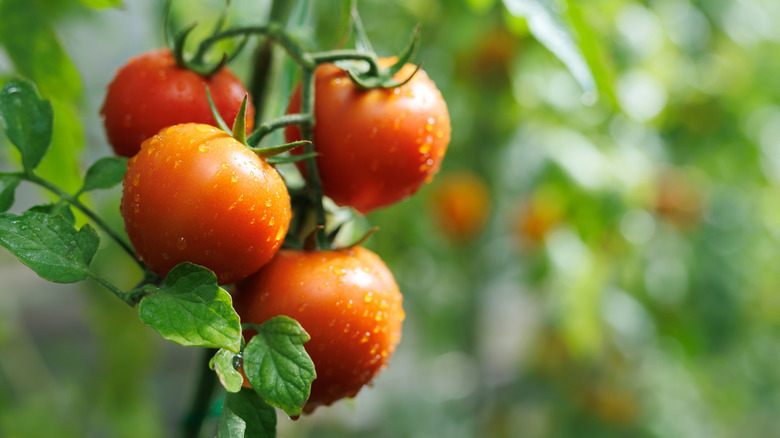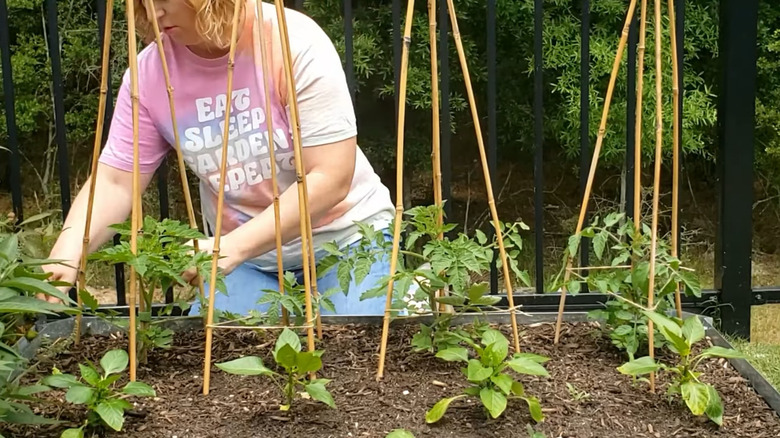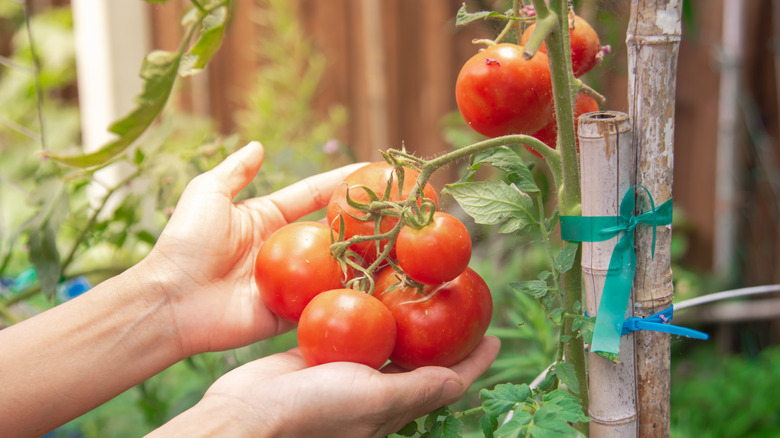Simple DIY Tomato Supports You Can Make With Just Wood
Tomato plants are awfully climb-y plants, the vines of which often become heavy-laden with the burden of the fruit on the plant's limbs. That's where tomato supports come in, and while there are all kinds, including tomato cages, you should consider other types, including wooden ones. Aside from looking more natural and organic, many of these gardening solutions don't restrict the airflow and sunlight the way metal tomato cages might. Additionally, the density of leaves inside the round metal cages can sometimes encourage pests to come in and roost, and they're a breeding ground for plant diseases.
More issues make using metal cages for tomatoes less practical than wooden supports. Some determinate tomato varieties, like 'Beefsteak' tomatoes, become too physically heavy for the support, causing the metal wire to buckle under the weight of the fruit. Some indeterminate tomato types, like cherry tomatoes, produce tall, practically "Jack and the Beanstalk" height vines. Most of these plants outgrow the metal cage, becoming too tall for the support that holds them.
Metal tomato cages work in a pinch, but really, they don't hold a candle to many of the wood support options you have. Two types of supports, in particular, work well when you're trying to grow the best tomato garden: the teepee-shaped garden trellis and support stakes. Each type is relatively simple to construct and work with, making the upkeep of your tomatoes simpler throughout the growing season.
The teepee tomato trellis
Some trellises are shaped more like a ladder and often lean up against a fence or some other kind of support. The teepee shape allows this type of support to be free-standing, which opens up more possibilities for where to construct it. This is an important consideration if you don't have a fence against which to lean the trellis. Teepee trellises have been used in gardening for a long time and not just for tomatoes. It was common in gardens of yesteryear to grow pole beans on teepee trellises, which were covered with leafy vines by midsummer. The construction for the tomato teepees is pretty much the same way the bean pole teepees did (and do).
The wooden poles or branches for these need to be tall – up to 8 feet – to give the tomatoes enough room to grow. Their length also allows them to be buried deeply into the ground, which keeps them solid and standing upright. Ideally, you'll plant 8 to 10 inches of the bottom of the poles into the ground.
There are other ways to give the structure more support. Placing a center pole in the middle of the teepee, plus a couple of cross beams to connect the outer supports together, works really well. Finally, bamboo, long wooden branches, or discarded wood that you've found at a local farm auction all count among the materials you can use to make these supports.
Wooden stake tomato supports
Giving your tomato vines a few stakes to lean on is one of the simplest ways to support your tomatoes as they grow taller. The raw materials for this type of tomato support are basically some wooden stakes that can be up to 7 feet or taller (if you're growing indeterminate tomatoes). You'll drive these into the ground, but unlike the supports on the teepee trellis, which are at an angle, these stand straight up. As such, this support should be deeply rooted into the ground — up to 24 inches.
You'll also need a bit of gardening twine to tie the tomatoes to the stake. Although this method is easy to set up and cheap to build, it does have drawbacks, and this is it. As the plant grows, you have to re-tie the stake over the course of the growing season because the leaves and branches on the tomato plant start to bump up against the twine that's holding them up.
Finally, it's worth noting that stakes are a good option for tomato supports if you want to grow a flourishing garden in a small space. Staking's compact footprint doesn't take up too much horizontal space and is only limited by the height of the stake you've given your tomato to climb. This makes staking a good solution for this gardening scenario where the real estate on the ground is limited.


